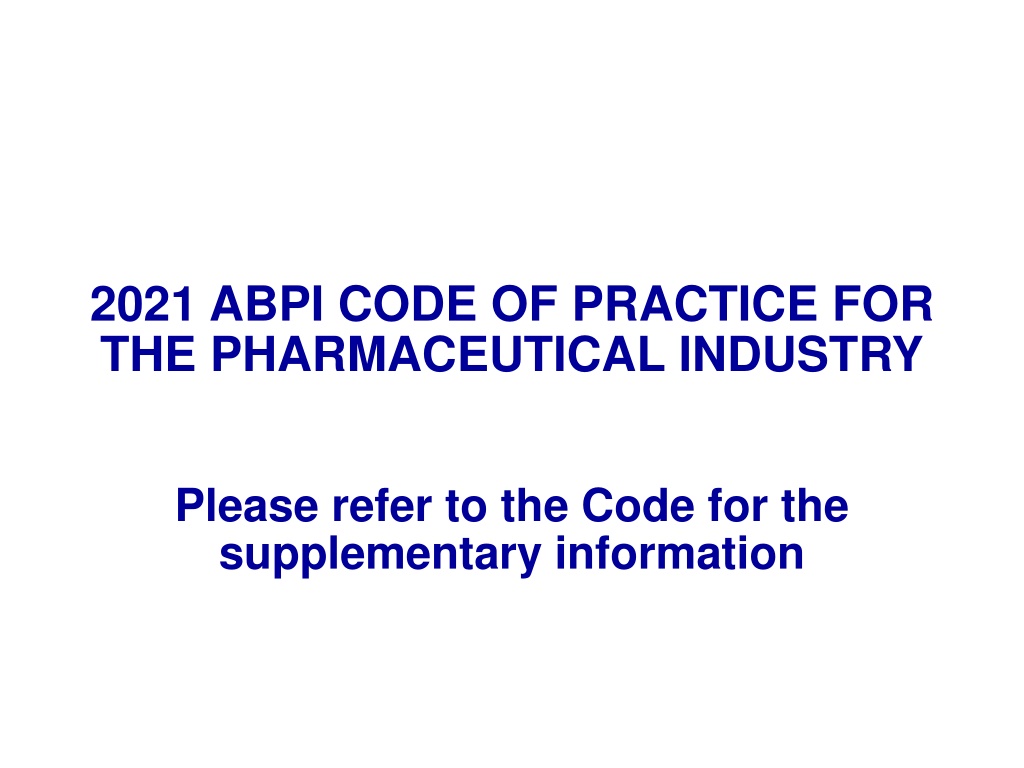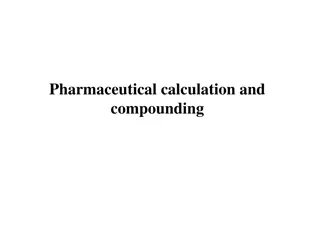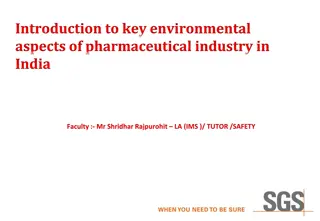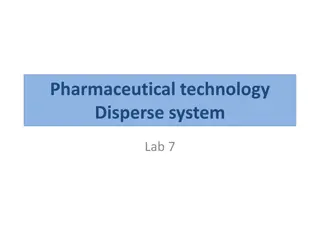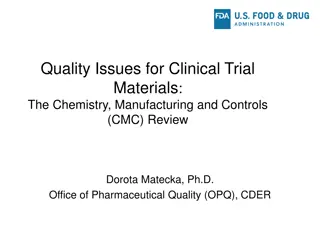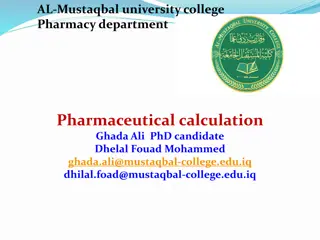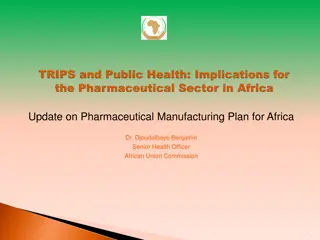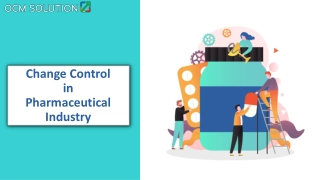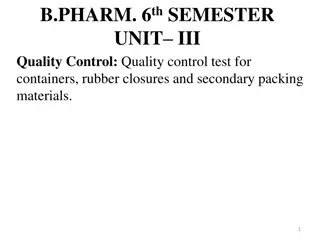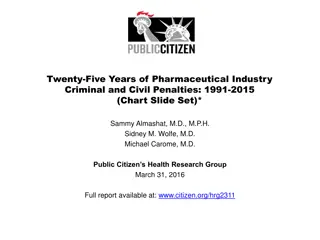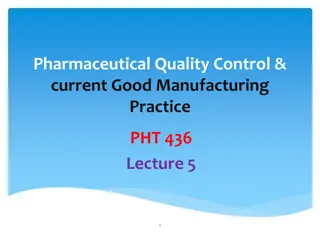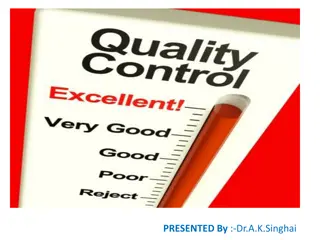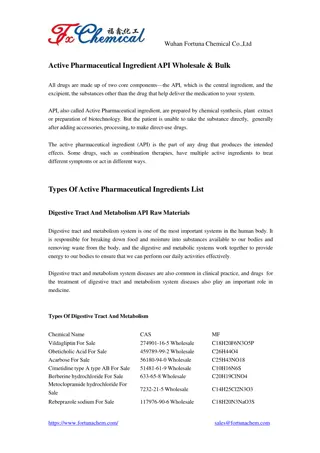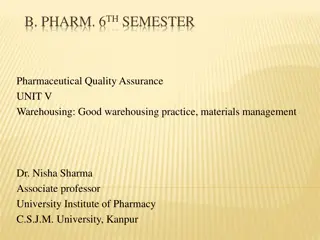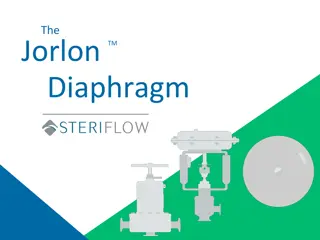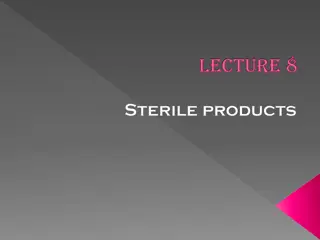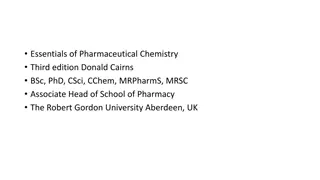2021 ABPI Code of Practice for the Pharmaceutical Industry Overview
The 2021 ABPI Code of Practice outlines requirements and responsibilities for pharmaceutical companies when promoting medicines in the UK. It covers aspects like quality standards, information dissemination, collaborations, and financial contributions related to events. The Code emphasizes ethical practices and transparency in interactions with healthcare professionals and decision-makers.
Download Presentation

Please find below an Image/Link to download the presentation.
The content on the website is provided AS IS for your information and personal use only. It may not be sold, licensed, or shared on other websites without obtaining consent from the author. Download presentation by click this link. If you encounter any issues during the download, it is possible that the publisher has removed the file from their server.
E N D
Presentation Transcript
2021 ABPI CODE OF PRACTICE FOR THE PHARMACEUTICAL INDUSTRY Please refer to the Code for the supplementary information
OverarchingRequirements Clauses 1-10 (Grey Section) Overarching Requirements Grey Section Scope of the Code and Definition of Certain Terms Clauses 1.1 & 28.2 Clause 1.2, 1.3, 1.4, 1.5, 1.6, 1.7, 1.8, 1.9, 1.10, 13.2, 17si, 23.2si, 24.1si, 27.1 Clause 1 Obligations and Responsibilities Clause 2 - Upholding Confidence in the Industry Clause 2 Clause 2 Obligations Clauses 1.11, 1.12, 3.1, 12.1, 26.1, 29 Clause 3 Responsibilities Clausees 13.1, 13.3, 24.1, 25.1, 25.2, 26.5, 27.7, 27.8 Clause 4 Quality Standards High Standards and Suitability Clauses 9.1, 9.2, 9.3, 9.7, 9.10, 11.1, 28.6 Clause 5 Information, Claims, Comparisons and Disparagement Clauses 7.2, 7.4, 7.8, 7.9, 7.11, 8.1, 8.2 Clause 6 Use of Quotations Clauses 10.2, 10.3 Clause 7 Certification and Examination Clauses 14.1, 14.2, 14.3, 14.4, 14.5, 14.6 Clause 8 Training Clauses 15.1, 16.1, 16.2, 16.3, 16.4 Clause 9 Events/Meetings and Hospitality? Clauses 18.1si, 18.3, 18.3si, 22.1, 22.1si, 22.2, 22.3, 22.4, 22.5, 24.2, 27.3 Clause 10
Clause 1 Scope of the Code and Definition of Certain Terms 1.1 This Code applies to the promotion of medicines to members of the United Kingdom (UK) health professions and to other relevant decision makers. For the purposes of the application of the Code, the UK includes the Channel Islands and the Isle of Man. The Code also applies to a number of areas which are non- promotional, including information made available to the public about prescription only medicines. It does not apply to the promotion of over-the-counter (OTC) medicines to members of the health professions when the object of that promotion is to encourage their purchase by members of the public. 1.2 Information or promotional material about medicines which is placed on the internet outside the UK will be regarded as coming within the scope of the Code, if it was placed there by: a UK company/with a UK company s authority, or an affiliate of a UK company, or with the authority of such a company, and it makes specific reference to the availability or use of the medicine in the UK.
Clause 1 Scope of the Code and Definition of Certain Terms 1.3 Collaborative Working refers to pharmaceutical companies working with other organisations to deliver initiatives which either enhance patient care or are for the benefit of patients or alternatively benefit the National Health Service (NHS) and, as a minimum, maintain patient care. Further details are given in Clause 20. 1.4 Contribution to costs related to events in relation to the disclosure of transfers of value means providing or covering the costs of travel, accommodation and/or registration fees to support the attendance of an individual to an event organised or created by a company and/or independent organisation. When providing sponsorship of events/meetings to organisations, associations etc such contributions may include costs for subsistence (food and drink). 1.5 Donations and grants collectively mean providing funds, benefits-in-kind or services freely given for the purpose of supporting healthcare, scientific research or education, with no consequent obligation on the recipient organisation, institution and the like to provide goods or services to the benefit of the pharmaceutical company in return. Donations and grants to individuals are prohibited. In general, donations are physical items, services or benefits-in-kind which may be offered or requested. Grants are the provision of funds.
Clause 1 Scope of the Code and Definition of Certain Terms 1.6 Europe comprises those countries that are within the European Union and other countries with a trade association that is a member of the European Federation of Pharmaceutical Industries and Associations (EFPIA). 1.7 Events includes all professional, promotional, scientific and educational meetings, congresses, conferences, symposia, and other similar events (including, but not limited to, advisory board meetings, visits to research or manufacturing facilities, and planning, training or investigator meetings for clinical trials and non- interventional studies) organised or sponsored by or on behalf of a company (further examples can be found in the supplementary information to Clause 10.1). 1.8 Healthcare organisation means either a healthcare, medical or scientific association or organisation such as a hospital, clinic, foundation, university or other teaching institution or learned society whose business address, place of incorporation or primary place of operation is in Europe or an organisation through which one or more health professionals or other relevant decision makers provide services. If a healthcare organisation consists of only one health professional or other relevant decision maker, then it would be subject to the requirements in the Code regarding individual health professionals.
Clause 1 Scope of the Code and Definition of Certain Terms 1.9 Health professional includes any member of the medical, dental, pharmacy or nursing profession and any other person who in the course of their professional activities may administer, prescribe, purchase, recommend or supply a medicine. In relation to the annual disclosure of transfers of value (Clause 28), the term also includes any employee of a pharmaceutical company whose primary occupation is that of a practising health professional. 1.10 Hospitality is limited to travel, subsistence (food and drink), accommodation and genuine registration fees extended in connection with events/meetings. 1.11 Medicine means any branded or unbranded medicine intended for use in humans which requires a marketing authorisation. 1.12 Non-interventional study is defined as a study of a marketed medicine where the medicine is prescribed in the usual manner in accordance with the terms of its marketing authorisation. The assignment of the patient to a particular therapeutic strategy is not decided by a study protocol but falls within current practice and the prescription of the medicine is clearly separated from the decision to include the patient in the study. No additional diagnostic or monitoring procedures are applied to the patients and epidemiological methods are used for the analysis of collected data.
Clause 1 Scope of the Code and Definition of Certain Terms 1.13 Other relevant decision maker particularly includes someone with an NHS role who could influence in any way the administration, consumption, prescription, purchase, recommendation, sale, supply or use of any medicine but who is not a health professional. 1.14 Over-the-counter medicine means a medicine or particular pack of medicine which is primarily advertised to the public for use in self-medication. 1.15 Patient organisation means an organisation mainly comprising of patients and/or caregivers or any user organisation such as disability organisation, carer or relative organisation and consumer organisation that represents and/or supports the needs of patients and/or caregivers. 1.16 Individuals Representing Patient Organisations means a person who is mandated to represent and express the views of a patient organisation.
Clause 1 Scope of the Code and Definition of Certain Terms 1.17 Promotion means any activity undertaken by a pharmaceutical company or with its authority which promotes the administration, consumption, prescription, purchase, recommendation, sale, supply or use of its medicines. It includes: journal and direct mail advertising the activities of representatives, including any electronic or printed material used by them the supply of samples the provision of inducements to prescribe, supply, administer, recommend, buy or sell medicines by the gift, offer or promise of any benefit or bonus, whether in money or in-kind the provision of hospitality for promotional purposes the sponsorship of promotional events/meetings the sponsorship of scientific events/meetings, including payment of travelling and accommodation expenses in connection therewith all other promotion. Cont d
Clause 1 Scope of the Code and Definition of Certain Terms 1.17 Promotion means any activity undertaken by a pharmaceutical company or with its authority which promotes the administration, consumption, prescription, purchase, recommendation, sale, supply or use of its medicines. It does not include: replies made in response to unsolicited individual enquiries from members of the health professions or other relevant decision makers or in response to specific communications from them whether of enquiry or comment, including letters published in professional journals, but only if they relate solely to the subject matter of the letter or enquiry, are accurate and do not mislead and are not promotional in nature factual, accurate, informative announcements and reference material concerning licensed medicines and relating, for example, to pack changes, adverse reaction warnings, trade catalogues and price lists, provided they include no product claims price lists relating to unlicensed medicines, provided they include no product claims and they make clear that the products are unlicensed Cont d
Clause 1 Scope of the Code and Definition of Certain Terms 1.17 Promotion means any activity undertaken by a pharmaceutical company or with its authority which promotes the administration, consumption, prescription, purchase, recommendation, sale, supply or use of its medicines. It does not include: information supplied by pharmaceutical companies to national public organisations such as the National Institute for Health and Care Excellence (NICE), the All Wales Medicines Strategy Group (AWMSG) and the Scottish Medicines Consortium (SMC) is exempt from the Code provided the information is factual, accurate and not misleading measures or trade practices relating to prices, margins or discounts which were in regular use by a significant proportion of the pharmaceutical industry on 1 January 1993 summaries of product characteristics European public assessment reports UK public assessment reports risk minimisation material approved by the Medicines and Healthcare products Regulatory Agency (MHRA) the labelling on medicines and accompanying package leaflets insofar as they are not promotional for the medicines concerned; the contents of labels and package leaflets are covered by regulations information relating to human health or diseases provided there is no direct or indirect reference to specific medicines.
Clause 1 Scope of the Code and Definition of Certain Terms 1.18 Promotional aid means a non-monetary item given for a promotional purpose. Promotional aids may be given to health professionals and other relevant decision makers only in accordance with Clause 10.4. Health professionals may, however, be provided with items which are to be passed on to patients in accordance with Clause 19.2. 1.19 Representative means a representative calling on members of the health professions and other relevant decision makers in relation to the promotion of medicines. 1.20 Research and Development Transfers of Value means, for the purposes of disclosure, transfers of value to health professionals or healthcare organisations related to the planning or conduct of: i) non-clinical studies (as defined in the OECD Principles on Good Laboratory Practice) ii) clinical trials (as defined in Regulation 536/2014) iii) non-interventional studies that are prospective in nature and that involve the collection of patient data from or on behalf of individual, or groups of, health professionals specifically for the study.
Clause 1 Scope of the Code and Definition of Certain Terms 1.21 Sample means a small supply of a medicine provided to health professionals so that they may familiarise themselves with it and acquire experience in dealing with it. A sample of a medicine may be provided only to a health professional qualified to prescribe that particular medicine. 1.22 A company can provide sponsorship for an activity to certain organisations. Sponsorship means a contribution, financial or otherwise, in whole or in part provided by or on behalf of a company, towards an activity (including an event/meeting or material) performed, organised, created etc by a healthcare organisation, patient organisation or other independent organisation. 1.23 A company can provide support for individual health professionals or other relevant decision makers to attend events/meetings. Support in this context is the provision of a financial contribution, in whole or in part, whether paid directly or indirectly to individual health professionals or other relevant decision makers to attend events/meetings.
Clause 1 Scope of the Code and Definition of Certain Terms 1.24 Third party means a legal person/entity or individual that represents a company or interacts with other parties on behalf of a company or relating to a company s medicine, such as distributors, wholesalers, consultants, contract research organisations, professional congress organisers, contracted sales forces, market research companies, advertising agencies, media buyers, providers of services related to events, public relations services, non-clinical services, non-interventional studies management services etc. Companies are responsible under the Code for the acts and omissions of their third parties which come within the scope of the Code, even if they act contrary to the instructions which they have been given.
Clause 1 Scope of the Code and Definition of Certain Terms 1.25 Transfer of value means a direct or indirect transfer of value, whether in cash, in-kind or otherwise, made, whether for promotional purposes or otherwise, in connection with the development or sale of medicines. A direct transfer of value is one made directly by a company for the benefit of a recipient. An indirect transfer of value is one made on behalf of a company for the benefit of a recipient or through an intermediate and where the company knows or can identify the recipient that will benefit from the transfer of value. The following are not transfers of value for the purposes of the Code: transfers of value that are solely related to over-the-counter medicines ordinary course purchases and sales of medicines by and between a company and a health professional or a healthcare organisation samples of medicines provided in accordance with Clause 21 transfers of value provided in accordance with Clauses 10.4, 10.5 and 19.2 subsistence provided to health professionals and other relevant decision makers in accordance with Clause 10.1.
OBLIGATIONS AND RESPONSIBILITIES Clauses 2 - 4
Clause 2 Upholding Confidence in the Industry Activities or materials must never be such as to bring discredit upon, or reduce confidence in, the pharmaceutical industry.
Clause 3 Obligations 3.1 A medicine must not be promoted prior to the grant of the marketing authorisation which permits its sale or supply. 3.2 Prescription only medicines must not be advertised to the public. This prohibition does not apply to vaccination and other campaigns carried out by companies and approved by the health ministers. 3.3 When an undertaking has been given in relation to a ruling under the Code, the company concerned must ensure that it complies with that undertaking. 3.4 Companies must comply with all applicable codes, laws and regulations to which they are subject.
Clause 3 Obligations 3.5 Gifts for personal benefit (such as sporting or entertainment tickets, social courtesy gifts) are prohibited and must not be given, either directly or indirectly, to any individual health professional, other relevant decision maker or individual associated with a healthcare organisation or patient organisation. Providing or offering cash, cash equivalents or the provision of services that confer a personal benefit to the recipient is prohibited. 3.6 Materials and activities must not be disguised promotion. 3.7 Each company must appoint a senior employee to be responsible for ensuring that the company meets the requirements of the Code.
Clause 4 Responsibilities 4.1 Companies must have a scientific service to compile and collate all information received from any source, about the medicines which they market. 4.2 Companies must have a scientific service to deal with the approval and supervision of non-interventional studies. This scientific service must include a registered medical practitioner, or a pharmacist registered in the UK who will be responsible for the oversight of non-interventional studies (including the review of any responsibilities relating to such studies particularly those given to representatives) and certification of the protocol. 4.3 Companies must document and publicly disclose certain transfers of value made directly or indirectly to health professionals, other relevant decision makers and healthcare organisations located in Europe as set out in Clause 28. This includes any employee of a pharmaceutical company whose primary occupation is that of a practising health professional.
Clause 4 Responsibilities 4.4 Companies must document and publicly disclose annually donations and grants whether financial, non-financial or a benefit-in-kind, and sponsorship (including in relation to events/meetings) made to patient organisations. Fees and expenses for the provision of contracted services including those performed by individuals representing patient organisations, which should be paid to patient organisations must also be publicly disclosed annually as set out in Clause 29. 4.5 Companies must document and publicly disclose annually fees and expenses made to individual members of the public, including patients and journalists, for the provision of contracted services performed as set out in Clause 30.
Clause 4 Responsibilities 4.6 Companies must disclose details of clinical trials in accordance with the Joint Position on the Disclosure of Clinical Trial Information via Clinical Trial Registries and Databases and the Joint Position on the Publication of Clinical Trial Results in the Scientific Literature. Companies must include on the home page of their website information as to where details of their clinical trials can be found. 4.7 Companies must publish the summary details and results of non- interventional studies of marketed medicines in a manner consistent with their parallel obligations with respect to clinical trials. 4.8 Companies are responsible for information about their products which is issued by their agencies eg communications, advertising etc.
QUALITY STANDARDS Clauses 5 - 10
Clause 5 High Standards and Suitability 5.1 High standards must be maintained at all times. 5.2 All material and activities must recognise the special nature of medicines and respect the professional standing or otherwise of the audience to which they are directed and must not be likely to cause offence. 5.3 The name or photograph of a member of a health profession must not be used in any way that is contrary to the conventions of that profession. 5.4 Extremes of format, size or cost of material must be avoided. Informational or educational materials must be inexpensive, directly relevant to the practice of medicine or pharmacy and directly beneficial to the care of patients.
Clause 5 High Standards and Suitability 5.5 Material relating to medicines and their uses, whether promotional or not, and information relating to human health or diseases which is sponsored by a pharmaceutical company or in which a pharmaceutical company has any other involvement, must clearly indicate the role of that pharmaceutical company. The only exception to this is market research material if it is such that the name of the company involved is not required to be stated; then the material must state that it is sponsored by a pharmaceutical company. 5.6 Material should only be provided or made available to those groups of people whose need for or interest in it can reasonably be assumed. Material should be tailored to the audience to whom it is directed. 5.7It should be made clear when a user is leaving any of the company s websites or websites sponsored by the company or is being directed to a website which is not that of the company.
Clause 6 Information, Claims, Comparisons and Disparagement Clauses 14 and 18 may also be relevant 6.1 Information, claims and comparisons must be accurate, balanced, fair, objective and unambiguous and must be based on an up-to-date evaluation of all the evidence and reflect that evidence clearly. They must not mislead either directly or by implication, by distortion, exaggeration or undue emphasis. Material must be sufficiently complete to enable recipients to form their own opinion of the therapeutic value of the medicine. 6.2 Any information, claim or comparison must be capable of substantiation. Companies must provide substantiation, following a request for it as set out in Clauses 14.3 and 18.2. In addition, when data from a clinical trial is used, companies must ensure that where necessary, that trial has been registered and the results disclosed in accordance with Clause 4.6.
Clause 6 Information, Claims, Comparisons and Disparagement Clauses 14 and 18 may also be relevant 6.3 All artwork, including illustrations, graphs and tables, must conform to the letter and spirit of the Code and, when taken from published studies, a reference must be given. Graphs and tables must be presented in such a way as to give a clear, fair, balanced view of the matters with which they deal and must not be included unless they are relevant to the claims or comparisons being made. 6.4 Information and claims about adverse reactions must reflect available evidence or be capable of substantiation by clinical experience. It must not be stated that a product has no adverse reactions, toxic hazards or risks of addiction or dependency. The word safe must not be used without qualification. 6.5The word new must not be used to describe any product or presentation which has been generally available, or any therapeutic indication which has been promoted, for more than twelve months in the UK. 6.6 The medicines, products and activities of other pharmaceutical companies must not be disparaged. 6.7 The health professions and the clinical and scientific opinions of health professionals must not be disparaged.
Clause 7 Use of Quotations 7.1 Quotations from medical and scientific literature or from personal communications must be faithfully reproduced, accurately reflect the meaning and current views of the author and otherwise comply with the Code. The precise source of the quotation must be identified. 7.2 Quotations relating to medicines taken from public broadcasts, for example, on radio and television, and from private occasions, such as medical conferences or symposia, must not be used without the formal permission of the speaker.
Clause 8 Certification and Examination 8.1 Promotional material must not be issued unless its final form, to which no subsequent amendments will be made, has been certified by one person on behalf of the company in the manner provided for by this clause, subject to the provisions of the supplementary information to this clause where relevant. This person must be a registered medical practitioner or a pharmacist registered in the UK or alternatively, in the case of a product for dental use only, a UK registered dentist. The person certifying on behalf of the company must not be the person responsible for developing or drawing up the material. 8.2All events/meetings involving travel outside the UK, unless the company s only involvement is to support a speaker to present at the meeting, must be certified in advance as set out in Clause 8.1 or by an appropriately qualified person signatory (AQP signatory) . That person does not need to be either a registered medical practitioner or a pharmacist registered in the UK.
Clause 8 Certification and Examination 8.3 The following must be certified in advance in a manner similar to that provided for by Clause 8.1: educational material for the public or patients issued by companies which relates to diseases or medicines but is not intended as promotion for those medicines material relating to working with patient organisations as described in Clause 27 and its supplementary information material relating to collaborative working as described in Clause 20 and its supplementary information material and items for patient support whether provided directly to patients or to health professionals to be passed on to patients as described in Clauses 19.2, 26.3 and associated supplementary information the written agreement for donations and grants including where relevant internal company and service provider instructions as described in Clause 23 and its supplementary information protocols relating to non-interventional studies.
Clause 8 Certification and Examination 8.4 The names of those nominated as signatories as set out in Clauses 8.1 and 8.2, together with their qualifications, must be notified in advance to the Advertising Standards and Outreach Unit, Vigilance and Risk Management of Medicines Division of the Medicines and Healthcare products Regulatory Agency (MHRA) and to the Prescription Medicines Code of Practice Authority (PMCPA). Changes in the names of nominees must be promptly notified. 8.5 The certificate for promotional material must certify that the signatory has examined the final form of the material to ensure that in their belief it is: in accordance with the requirements of the relevant regulations relating to advertising and this Code not inconsistent with the marketing authorisation and the summary of product characteristics a fair and truthful presentation of the facts about the medicine. The certificate for material covered by Clause 8.3 above must certify that the signatory has examined the final form of the material to ensure that in their belief it complies with the Code. Material which is still in use must be recertified at intervals of no more than two years to ensure that it continues to conform with the relevant regulations relating to advertising and the Code. The certificate for events/meetings involving travel outside the UK must certify that the signatory has examined all the proposed arrangements and that, in their belief, they are in accordance with the relevant regulations relating to advertising and the Code.
Clause 8 Certification and Examination 8.6 Companies must preserve certificates. Material in the form certified and information indicating the persons to whom it was addressed, the method of dissemination and the date of first dissemination must also be preserved. In relation to certificates for events/meetings involving travel outside the UK, details of the programme, the venue, the reasons for using the venue, the audience, the anticipated and actual costs and the nature of the hospitality and the like must also be preserved. Companies must preserve certificates and the relevant accompanying information for not less than three years after the final use of the material or the date of the event/meeting and produce them on request from the MHRA or the PMCPA.
Clause 9 Training 9.1 All relevant personnel, including representatives, and members of staff, and others retained by way of contract, concerned in any way with the preparation or approval of material or activities covered by the Code must be fully conversant with the Code and the relevant laws and regulations. 9.2 All personnel (and others retained by way of contract) must be fully conversant with pharmacovigilance requirements relevant to their work and, this must be documented. 9.3 Representatives must be given adequate training and have sufficient scientific knowledge to enable them to provide full and accurate information about the medicines which they promote.
Clause 9 Training 9.4 Representatives must take an appropriate examination within their first year of employment as a representative and must pass it within two years of starting such employment. To be acceptable, an appropriate examination must have been accredited to at least Level 3 or its equivalent by an external awarding body recognised by Ofqual. An appropriate examination for medical representatives is one that requires a broad understanding of body systems, diseases and treatments, the development of new medicines and the structure and function of the NHS and of the pharmaceutical industry. Such an examination must be a Diploma (equivalent to at least 480 hours Total Qualification Time). An appropriate examination for generic sales representatives is one that requires a broad understanding of body systems and the structure and function of the NHS and of the pharmaceutical industry. Such an examination must be a Certificate (equivalent to at least 330 hours Total Qualification Time). An appropriate examination can be either the relevant ABPI examination (for medical or generic sales representatives) or an examination of at least the same standard which covers similar content and learning material as the corresponding ABPI examination. 9.5 Details of the numbers of representatives who have passed an examination, together with the examination status of others, must be provided to the PMCPA on request.
Clause 10 Events/Meetings and Hospitality 10.1 Pharmaceutical companies may hold, sponsor, or support delegates to attend a wide range of events/meetings, providing such events/meetings meet the requirements of the Code. This may include support of health professionals not known to the company via a healthcare organisation by way of registration fees, accommodation, and travel. Companies must not provide hospitality to health professionals, other relevant decision makers etc except in association with scientific meetings, promotional meetings, scientific congresses and other such meetings and training. Cont d
Clause 10 Events/Meetings and Hospitality 10.1cont d The content and arrangements for any event or meeting must also, to the extent relevant to the particular event/meeting, fulfil the following criteria: the event/meeting must have a clear educational content; it should be the programme that attracts delegates to attend and not the associated hospitality or venue the content must be appropriate and relevant to attendees the venue must be appropriate and conducive to the main purpose of the event/meeting; lavish, extravagant or deluxe venues must not be used any associated subsistence (food and drink), accommodation and travel costs must be strictly limited to the main purpose of the event/meeting, must be of secondary consideration and must be appropriate and not out of proportion to the occasion (see Clause 10.7) companies must not sponsor, support or organise entertainment (such as sporting or leisure activities, etc) any hospitality provided must not extend to an accompanying person unless that person qualifies as a proper delegate or participant at the meeting in their own right. In exceptional cases of established clear health needs of the delegate (eg disability or injury), similar hospitality may be provided for an accompanying person. Cont d
Clause 10 Events/Meetings and Hospitality 10.2 No payment may be offered or paid to individuals to compensate merely for the time spent in attending events/meetings. 10.3 Sponsorship of patient organisations (including individuals representing patient organisations to attend events/meetings) must have a written agreement in place setting out what has been agreed including, where possible, a breakdown of agreed costs. (The requirements for the written agreement are set out in Clause 27.2). 10.4 Attendees of company organised events/meetings may be provided with inexpensive pens, pencils and notepads when required for use at those events/meetings. They must not bear the name of any medicine or any information about medicines but may bear the name of the company providing them. No individual attendee should receive more than one pen or pencil or one notepad. The total cost to the donor company of all such items provided to an individual attending an event/meeting must not exceed 6, excluding VAT. The perceived value to the recipient must be similar.
Clause 10 Events/Meetings and Hospitality 10.5 Pens/pencils and notepads provided in conference bags at independently organised meetings must not include the name of the donor company, the name of any medicine or any information about medicines. The total cost to the donor company of all such items provided to an individual attending an event/meeting must not exceed 6, excluding VAT. The perceived value to the recipient must be similar. Pens/pencils and notepads must not be given out from exhibition stands. 10.6Quizzes which are intended to gauge attendees understanding of the subject matter of a meeting are acceptable provided that such quizzes are non- promotional and genuine tests of skill or knowledge; they must respect the professional standing or otherwise of the audience and no prizes can be offered. To be acceptable, a quiz must form part of the meeting s formal proceedings. Quizzes must not be conducted from or on exhibition stands. The use of competitions, quizzes and suchlike are unacceptable methods of promotion.
Clause 10 Events/Meetings and Hospitality 10.7 The cost of any subsistence (food and drink) provided must not exceed 75 per person, excluding VAT and gratuities. 10.8 Payments may not be made to doctors or groups of doctors, or to other prescribers, either directly or indirectly, for rental for rooms to be used for events/meetings. 10.9 When events/meetings are sponsored by pharmaceutical companies, that fact must be disclosed in all the material relating to the events/meetings and in any published proceedings. The declaration of sponsorship must be sufficiently prominent to ensure that readers are aware of it at the outset. 10.10 Companies must publicly disclose annually financial details of support of UK health professionals and other relevant decision makers in relation to attendance at events/meetings. 10.11 Companies must publicly disclose annually financial details for contributions to costs related to events/meetings (sponsorship) paid to healthcare organisations, patient organisations or organisations managing an event/meeting on their behalf. This may include support of health professionals not known to the company via the healthcare organisation by way of registration fees, accommodation and travel. Contracts for sponsorship of individuals representing patient organisations to attend events/meetings should be made with the patient organisation and disclosed against the patient organisation as set out in Clause 29.
Promotion to Health Professionals/Other Relevant Decision Makers Clauses 11 17 (Blue section) Blue Section Promotion to Health Professionals and Other Relevant Decision Makers Marketing Authorisation and Temporary Supply Authorisation Prescribing Information and Other Obligatory information Abbreviated Advertisements Information, Claims and Comparisons Clause 3.1, 3.2 Clause 11 Clause 4.1, 4.2, 4.3, 4.4, 4.5, 4.6, 4.7, 4.8, 4.9, 4.10 Clause 5.1, 5.2, 5.3, 5.4, 5.5, 5.6, 5.7, 5.8, 5.9 Clause 6.2, 7.3, 7.6, 7.7, 7.10 Clause 12 Clause 13 Clause 14 High Standards, Format and Suitability Material and Distribution Representatives Clause 9.4, 9.5, 9.6, 9.8, 9.9, 12.1 Clause 10.1, 11.2, 11.3, 28.1, 28.4 Clause 15.1, 15.2, 15.3, 15.4, 15.5, 15.6, 15.7, 15.8, 15.9, 15.10 Clause 15 Clause 16 Clause 17
Clause 11 Marketing Authorisation and Temporary Supply Authorisation 11.1 A medicine must not be promoted prior to the grant of the marketing authorisation which permits its sale or supply subject to the provisions of Clause 11.3 below. 11.2 The promotion of a medicine must be in accordance with the terms of its marketing authorisation and must not be inconsistent with the particulars listed in its summary of product characteristics subject to the provisions of Clause 11.3 below. 11.3 A medicine with a temporary supply authorisation must not be promoted unless it is part of a campaign that has been approved by the health ministers.
Clause 12 Prescribing Information and Other Obligatory Information 12.1 The prescribing information listed in Clause 12.2 must be provided in a clear and legible manner in all promotional material for a medicine except for abbreviated advertisements (see Clause 13). The prescribing information must be positioned for ease of reference and must not be presented in a manner such that the reader has to turn the material round in order to read it, for example, by providing it diagonally or around the page borders. The prescribing information must form part of the promotional material and must not be separate from it.
Clause 12 Prescribing Information and Other Obligatory Information 12.2 The prescribing information consists of the following: the legal classification of the product the cost (excluding VAT) of either a specified package of the medicine to which the advertisement relates, or a specified quantity or recommended daily dose, calculated by reference to any specified package of the product, except in the case of advertisements in journals printed in the UK which have more than 15 per cent of their circulation outside the UK and audiovisual advertisements and prescribing information provided in association with them and i. the name of the medicine (which may be either a brand name or a non- proprietary name) ii. a quantitative list of the active ingredients, using approved names where such exist, or other non-proprietary names; alternatively, the non-proprietary name of the product if it is the subject of an accepted monograph iii. at least one authorised indication for use consistent with the summary of product characteristics iv. a succinct statement of the information in the summary of product characteristics relating to the dosage and method of use relevant to the indications quoted in the advertisement and, where not otherwise obvious, the route of administration Cont d
Clause 12 Prescribing Information and Other Obligatory Information 12.2The prescribing information consists of the following (cont d): v. a succinct statement of common adverse reactions likely to be encountered in clinical practice, serious adverse reactions and precautions and contra- indications relevant to the indications in the advertisement, giving, in an abbreviated form, the substance of the relevant information in the summary of product characteristics, together with a statement that prescribers should consult the summary of product characteristics in relation to other adverse reactions vi. any warning issued by the Medicines Commission, the Commission on Human Medicines, the Committee on Safety of Medicines or the licensing authority, which is required to be included in advertisements vii. the number of the relevant marketing authorisation and the name and address of the holder of the authorisation or the name and address of the part of the business responsible for its sale or supply viii. the date the prescribing information was drawn up or last revised. The summary of product characteristics may be provided instead of i-viii above. If the summary of product characteristics is not used, then the information specified above in relation to iv, v, and vi which is required to be included in advertisements, must be placed in such a position in the advertisement that its relationship to the claims and indications for the product can be appreciated by the reader.
Clause 12 Prescribing Information and Other Obligatory Information 12.3 The non-proprietary name of the medicine or a list of the active ingredients using approved names where such exist must appear immediately adjacent to the most prominent display of the brand name in bold type of a size such that a lower case x is no less than 2mm in height or in type of such a size that the non- proprietary name or list of active ingredients occupies a total area no less than that taken up by the brand name. For electronic advertisements, the non-proprietary name of the medicine or the list of active ingredients, as required by Clause 12.3, must appear immediately adjacent to the brand name at its first appearance in a size such that the information is easily readable. 12.4 In digital material such as advertisements in electronic journals, emails, electronic detail aids and suchlike, the prescribing information as required by Clause 12.1 may be provided either: by inclusion in the digital material itself, or by way of a clear, and prominent, direct, single click link.
Clause 12 Prescribing Information and Other Obligatory Information 12.5 In audiovisual material and in interactive data systems, the prescribing information may be provided either: by way of a document which is made available to all persons to whom the material is shown or sent, or by inclusion on the audiovisual recording or in the interactive data system itself. When the prescribing information is included in an interactive data system, instructions for accessing it must be clearly displayed. 12.6 Promotional material provided on the internet must include a clear prominent statement as to where the prescribing information can be found. 12.7 In a printed journal advertisement the prescribing information must appear on at least one of the pages. The pages where the prescribing information is not visible must include a reference on the outer edge of the page as to where the prescribing information can be found in a type size such that a lower case x is no less than 2mm in height. 12.8 Promotional material other than advertisements in professional publications must include the date on which the promotional material was created or last revised.
Clause 12 Prescribing Information and Other Obligatory Information 12.9All promotional material must include the prominent statement Adverse events should be reported. Reporting forms and information can be found at [website address which links directly to the MHRA Yellow Card site]. Adverse events should also be reported to [relevant pharmaceutical company] . 12.10 When required by the licensing authority, all promotional material must clearly show an inverted black equilateral triangle to denote that additional monitoring is required in relation to adverse reactions. The symbol should always be black, and its size should normally be not less than 5mm per side but with a smaller size of 3mm per side for A5 size advertisements and a larger size of 7.5mm per side for A3 size advertisements. The symbol should appear once and be located adjacent to the most prominent display of the name of the product. No written explanation of the symbol is necessary. Digital communications are also covered by this requirement and the black triangle symbol should be located adjacent to the first mention of the product as this is likely to be considered the most prominent display of the name of the product. The size must be such that it is easily noticed.
Clause 13 Abbreviated Advertisements 13.1 Abbreviated advertisements are exempt from the requirement to include prescribing information for the advertised medicine, provided that they are limited in size and content as set out in this clause. 13.2 Abbreviated advertisements may only appear in professional publications, ie publications sent or delivered wholly or mainly to members of the health professions and/or other relevant decision makers. A loose insert in such a publication cannot be an abbreviated advertisement. Abbreviated advertisements may contain only the information specified in Clauses 13.4, 13.5, 13.6, 13.7, and 13.8. Abbreviated advertisements are not permitted in audiovisual material or in interactive data systems or on the internet, including journals on the internet. 13.3 Abbreviated advertisements must be no larger than 420 square centimetres in size.
Clause 13 Abbreviated Advertisements 13.4 Abbreviated advertisements must provide the following information in a clear and legible manner: the name of the medicine (which may be either a brand name or a non- proprietary name) the non-proprietary name of the medicine or a list of the active ingredients using approved names where such exist at least one indication for use consistent with the summary of product characteristics the legal classification of the product any warning issued by the Medicines Commission, the Commission on Human Medicines, the Committee on Safety of Medicines or the licensing authority which is required to be included in advertisements the name and address of the marketing authorisation holder or the name and address of the part of the business responsible for the medicine s sale or supply the statement: Information about this product, including adverse reactions, precautions, contra-indications and method of use can be found at [the address of the website referred to below] and state that prescribers are recommended to consult the summary of product characteristics before prescribing. Cont d
Clause 13 Abbreviated Advertisements 13.4 Abbreviated advertisements must provide the following information in a clear and legible manner (cont d): The website referred to above must provide either: the information set out in Clauses 12.2 and 12.3 (except that the non- proprietary name of the medicine or the list of active ingredients, as required by Clause 12.3, must appear immediately adjacent to the most prominent display of the brand name in a size such that the information is easily readable and information about cost, as required by Clause 12.2, need not be included on the website where the abbreviated advertisement appears only in journals printed in the UK which have more than 15 per cent of their circulation outside the UK), or the summary of product characteristics.
Clause 13 Abbreviated Advertisements 13.5 The non-proprietary name of the medicine or a list of the active ingredients using approved names where such exist must appear immediately adjacent to the most prominent display of the brand name in bold type of a size such that a lower case x is no less than 2mm in height or in type of such a size that the non-proprietary name or list of active ingredients occupies a total area no less than that taken up by the brand name. 13.6Abbreviated advertisements must include the prominent statement Adverse events should be reported. Reporting forms and information can be found at [website address which links directly to the MHRA Yellow Card site]. Adverse events should also be reported to [relevant pharmaceutical company] . 13.7 When required by the licensing authority, abbreviated advertisements must clearly show an inverted black equilateral triangle to denote that additional monitoring is required in relation to adverse reactions. It should be borne in mind that abbreviated advertisements must be no larger than 420 square centimetres in size. In abbreviated advertisements of no more than 310.8 square centimetres (A5) each side of the triangle should be no less than 3mm. In abbreviated advertisements larger than A5 (but no larger than 420 square centimetres) each side should be no less than 5mm. The other relevant requirements of Clause 12.10 apply equally to the use of the black triangle symbol on abbreviated advertisements. 13.8 Abbreviated advertisements may contain a concise statement consistent with the summary of product characteristics, giving the reason why the medicine is recommended for the indication or indications given. 13.9 Marketing authorisation numbers and references must not be included in abbreviated advertisements.
